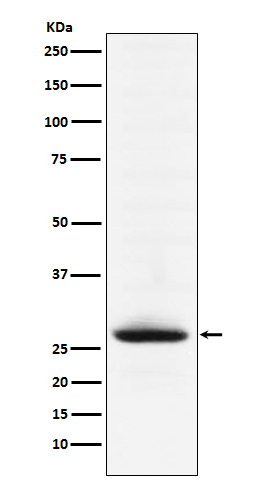
| WB | 咨询技术 | Human,Mouse,Rat |
| IF | 咨询技术 | Human,Mouse,Rat |
| IHC | IHC:1/100-1/200;IHF:1/50-1/200 | Human,Mouse,Rat |
| ICC | 1/50-1/200 | Human,Mouse,Rat |
| FCM | 咨询技术 | Human,Mouse,Rat |
| Elisa | 咨询技术 | Human,Mouse,Rat |
| Aliases | BTN6; BTNL11; MOG alpha 5; MOG alpha 6; MOG AluA; MOG AluB; MOG; MOG Ig AluB; MOGIG2; Myelin oligodendrocyte glycoprotein; NRCLP7;;Myelin oligodendrocyte glycoprotein |
| WB Predicted band size | 28 kDa |
| Host/Isotype | Rabbit IgG |
| Antibody Type | Primary antibody |
| Storage | Store at 4°C short term. Aliquot and store at -20°C long term. Avoid freeze/thaw cycles. |
| Species Reactivity | Human,Mouse,Rat |
| Immunogen | A synthesized peptide derived from human Myelin oligodendrocyte glycoprotein |
| Formulation | Purified antibody in PBS with 0.05% sodium azide,0.05% BSA and 50% glycerol. |
+ +
以下是3-4篇关于 **MOG抗体(Myelin Oligodendrocyte Glycoprotein抗体)** 的参考文献及其简要摘要:
---
1. **文献名称**: *MOG encephalomyelitis: international recommendations on diagnosis and antibody testing*
**作者**: Jarius S, et al.
**摘要**: 该综述总结了MOG抗体相关疾病的临床特征(如视神经炎、横贯性脊髓炎、脑炎等),强调其与AQP4抗体阴性NMOSD的区分,并提出了标准化的抗体检测方法(基于细胞底物的检测法)及诊断流程。
---
2. **文献名称**: *MOG antibody-associated demyelinating syndromes: Current concepts on clinical disease and pathogenic mechanisms*
**作者**: Reindl M, et al.
**摘要**: 探讨MOG抗体在脱髓鞘疾病中的致病机制,指出MOG抗体可能通过补体激活或抗体依赖性细胞毒性直接攻击髓鞘,并通过动物模型研究支持其病理作用,同时分析其与多发性硬化的临床差异。
---
3. **文献名称**: *Clinical features of paediatric and adult patients with MOG antibody-associated encephalomyelitis*
**作者**: Waters P, et al.
**摘要**: 比较儿童与成人MOG抗体阳性患者的临床表现,发现儿童更易出现急性播散性脑脊髓炎(ADEM),而成人以视神经炎和长节段脊髓炎为主,并提示儿童患者总体预后较好。
---
4. **文献名称**: *Clinical spectrum and prognostic value of CNS MOG autoimmunity in adults: The MOGADOR study*
**作者**: Cobo-Calvo A, et al.
**摘要**: 通过队列研究分析成人MOG抗体阳性患者的长期预后,发现早期免疫治疗可降低复发风险,且部分患者呈单相病程,但复发病例易遗留视觉或运动功能障碍。
---
这些文献覆盖了MOG抗体的临床特征、诊断标准、病理机制及预后,可为相关研究提供基础参考。如需具体DOI或期刊年份,可进一步补充。
Myelin oligodendrocyte glycoprotein (MOG) antibody is associated with immune-mediated demyelinating disorders of the central nervous system (CNS). MOG, a protein expressed on the surface of myelin sheaths and oligodendrocyte membranes, plays a role in maintaining myelin integrity. Antibodies targeting MOG are detected in a subset of patients with conditions like neuromyelitis optica spectrum disorder (NMOSD), acute disseminated encephalomyelitis (ADEM), and optic neuritis. Unlike aquaporin-4 (AQP4) antibodies in NMOSD, MOG antibodies often define a distinct clinical entity, termed MOG antibody-associated disease (MOGAD), characterized by relapsing or monophasic courses.
MOGAD typically presents with optic neuritis, transverse myelitis, or brainstem syndromes. It affects both adults and children, with pediatric cases frequently linked to ADEM-like presentations. Diagnosis relies on cell-based assays (CBA) to detect serum IgG antibodies against conformationally intact MOG, ensuring higher specificity. Clinically, MOGAD lesions often show transient, widespread MRI abnormalities but generally exhibit better recovery and lower relapse rates compared to AQP4-NMOSD or multiple sclerosis (MS). However, severe attacks may lead to residual deficits.
Treatment involves high-dose corticosteroids for acute attacks, with immunosuppressants like rituximab or mycophenolate considered for relapse prevention. Research continues to clarify its pathophysiology, optimal management, and long-term outcomes. MOG antibody testing has refined diagnostic precision, distinguishing it from MS and AQP4-NMOSD, thereby guiding tailored therapeutic strategies.
×